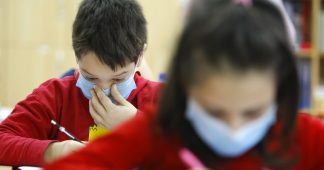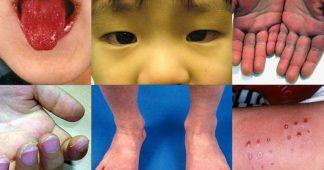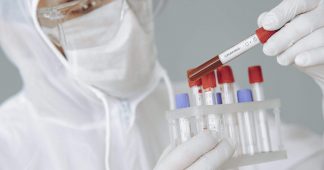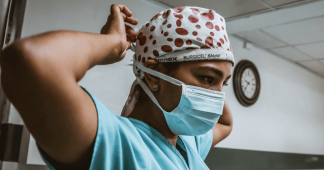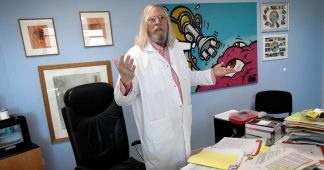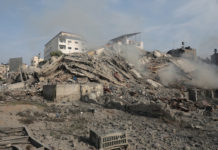A growing number of clinicians are on an urgent quest to find treatments for a frighteningly pervasive problem. They’ve had surprising early success.
by Meghan O’Rourke
March 8, 2021
A new guide to living through climate change. Robinson Meyer brings you the biggest ideas and most vital information to help you flourish on a changing planet.
Photographs by Jonno Rattman
Image above: Nearly a year after she was infected with the coronavirus, Caitlin Barber still uses a wheelchair outside.
The quest at Mount Sinai began with a mystery. During the first wave of the coronavirus pandemic in New York City, Zijian Chen, an endocrinologist, had been appointed medical director of the hospital’s new Center for Post-COVID Care, dedicated both to research and to helping recovering patients “transition from hospital to home,” as Mount Sinai put it. One day last spring, he turned to an online survey of COVID‑19 patients who were more than a month past their initial infection but still experiencing symptoms. Because COVID‑19 was thought to be a two-week respiratory illness, Chen anticipated that he would find only a small number of people who were still sick. That’s not what he saw.
“We didn’t expect this from a virus,” he continued. “We expect that with viral infections as a whole, with few exceptions, you get better.” Many patients who spend significant time in an ICU—whether battling an infection or recovering from a stroke—do require further treatment even after they are released, because they suffer from something called post–intensive care syndrome, often characterized by weakness and cognitive problems. But that didn’t explain the group Chen was looking at. Startlingly, most had had mild cases of COVID‑19—they had neither been hospitalized nor developed pneumonia. Before contracting the virus, many had had no known health issues. Yet they were reporting significant ongoing symptoms—“shortness of breath, heart palpitations, chest pain, fatigue, and brain fog,” Chen told me.
Chen quickly convened a multidisciplinary group of clinicians. The team began triaging patients with ongoing symptoms, referring them to specialists and teasing apart the causes. There were patients of all ages and backgrounds, with a wide array of problems, from persistent loss of taste and smell to chest pain. Some patients had been seriously ill, and they typically had the lung scarring, or fibrosis, that comes with COVID pneumonia; they were referred to pulmonologists for follow-up care. Others had readily observable heart problems, including myocarditis, an inflammation of the heart muscle, and were referred to cardiologists. Still others had blood clots. The extent of the damage COVID‑19 had done to them was highly unusual for a respiratory virus—and deeply alarming. But, Chen told me, “those were actually the luckier patients, because we could target treatment toward that.”
These patients’ tests usually showed nothing obviously the matter with them. “Everything was coming back negative,” says Dayna McCarthy, a rehabilitation-medicine physician and a lead clinician at the center. “So of course Western medicine wants to say, ‘You’re fine.’ ”
But the patients were self-evidently not fine. An international survey by Patient-Led Research for COVID‑19, one of various groups drawing attention to persisting problems, asked nearly 3,800 patients with ongoing illness to describe their symptoms. A significant number—85.9 percent—reported having relapses in the months after their initial infection, usually triggered by mental or physical exertion. (Not all patients in this group had confirmed cases of COVID‑19, given that tests were hard to come by last March and April.) Many patients were experiencing severe fatigue and brain fog. Other patients suffered from chest tightness and tachycardia—a condition in which the heart beats more than 100 times a minute—when they stood up or walked. Others had diarrhea and lost their appetite; some had terrible bone pain. Nearly a quarter said they were still unable to work; many had gone on disability or taken medical leave. Patient groups of COVID‑19 “long-haulers” were springing up on Facebook and elsewhere online, where people shared data and compared notes about what they began to call “long COVID.”
Read: Long-haulers are redefining COVID-19
Barber’s case of COVID‑19 wasn’t bad. “It was kind of like a cold for me; I got very lucky in that respect.” Two weeks later, she went back to work. “Within three days, my world just crashed,” she said. She had difficulty writing simple reports. In the middle of a routine feeding-tube procedure—“Dietitian 101,” she told me—she found herself, tube in hand, unsure what to do next. She called her supervisor to take over. After a few such failed attempts to work, she went on medical leave.
Nearly a year later, Barber is mostly bedbound: “My symptoms change all the time. I’m happy if I can take a shower.” She struggles to brush her teeth or prepare meals, because her heart races to 180 beats a minute. (A typical rate is 60 to 100.) Convulsions sent her to the emergency room in September. She is alone most of the day—her husband works long hours—and she has to plan carefully in order to use the bathroom and feed herself without collapsing. There are chairs placed strategically throughout her apartment for her to rest on. Her friends ask her what she does all day at home. “I feel like I am very busy,” she told me drily. It can take her a whole day to wash her bedding, because of the spikes in her heart rate.
Early on, many doctors, predictably, dismissed these cases as the result of anxiety or hypochondria. But at Mount Sinai, Chen and others tried to figure out what was happening. Their interest was not just academic. Beyond the terrifying impact on individual lives, the scope of the problem immediately alarmed them. “My goodness, the economic implications of this,” McCarthy told me. “You’re talking a huge number of 20-to-40-year-olds—our workforce—who now can’t work.”
Today, informal estimates suggest that 10 to 30 percent of those infected with the novel coronavirus have long-term symptoms. “What people need to know is the pandemic’s toll is likely much higher than we are imagining,” Craig Spencer, the director of global health in emergency medicine at New York–Presbyterian/Columbia University Irving Medical Center, told me. “It is an area that merits urgent attention. There will be people living with the impact of COVID long after the pandemic is over. This is not made up or in the minds of people who are sickly. This is real.”
And so, even as research scientists were developing the vaccines that will help bring an end to the acute phase of the pandemic later this year, the doctors at Mount Sinai and other academic medical centers began working to understand, and treat, the destruction that it is leaving behind. The unusual speed and scale of the effort are born of urgency. In many ways, the pace of progress has been remarkable, and innovations of a surprisingly low-tech sort are yielding results. But we still face a crisis of as-yet-unknown proportions that may change our medical system, our ideas about infectious disease—and the future of millions of Americans
Last April, the quest became the consuming focus of another group of Mount Sinai clinicians, known for its novel approaches to problems for which medicine doesn’t have easy answers. David Putrino is the director of rehabilitation innovation for the Mount Sinai Health System. Putrino spends his time on questions that many doctors don’t think about, including “measuring things that are hard to measure,” he told me. Before the pandemic, he was treating professional baseball and basketball players in his “high performance” clinic and doing TEDx Talks about the brain’s remarkable ability to heal itself. After the pandemic hit, with ICUs full and the hospital overtaxed, Putrino’s team built a platform to remotely monitor patients with suspected coronavirus infections who at other times might have been admitted to the hospital. This triage helped many sick patients stay out of the ER while Putrino’s team watched their oxygen levels.
“And then my team started seeing these cases that weren’t getting better,” he told me. “My physical therapists were saying, ‘These symptoms are really different from those of acute COVID. We don’t know what to do with them.’ ”
When Putrino looked at the data, he saw the same symptoms that Chen saw. To Putrino, they looked like those of patients who suffer from a poorly understood and often misdiagnosed condition, one that he happens to know a lot about because his wife lives with it: dysautonomia, or impairment of the usual functioning of the autonomic nervous system, which controls blood pressure, temperature regulation, and digestion. Dysautonomia is itself an umbrella term for a host of different conditions, many of whose causes have yet to be fully pinned down. In common manifestations of it, a patient’s autonomic nervous system has trouble regulating the heart’s response to exertion, changes in posture, or variations in temperature, sending the body into an inappropriate fight-or-flight response. Some patients’ systems have trouble adjusting blood pressure or constricting blood vessels to send blood to the brain. Blood can pool in the legs and peripheries of the body; the heart might compensate by increasing its rate, while the body releases surges of adrenaline in a fruitless attempt to correct the problem. As a result, patients can experience some blend of fatigue, headaches, digestive problems, heart palpitations, difficulty breathing, and cognitive issues such as brain fog.
Kontorovich was prepared for the call. A key clue had come her way : Two weeks earlier, she had received an email from a doctor she knew named Jessica Cohen, a 38-year-old who worked at a New York–area hospital. Cohen had tested positive for COVID‑19 on March 8—at the start of the first wave in New York—a few days after her husband returned from a trip to Scotland feeling logy. The couple have two young children. “I told him to ‘get over it,’ ” she says. “In retrospect, that may not have been the right thing to say.”
At first her illness was relatively mild, like her husband’s. Tracking her oxygen levels and heart rate with her smartwatch, she felt she had gotten lucky. But on the eighth day—March 16—she went to the bathroom, and her heart began to race, beating more than 140 times per minute. Worried she had a blood clot, she texted a colleague, who told her to go to the ER. No one yet had any idea what COVID‑19 did to the heart.
That week, she forced herself to walk up the stairs in her house, only to collapse at the landing. She started having diarrhea and bouts of intense fatigue and severe headaches. One day she walked four blocks with her daughter to the store, where her heart began racing so fast that she had to sit down on the sidewalk until her husband came to pick them up.
Cohen began posting in a doctors’ group on Facebook, eager to find out whether any of her colleagues had patients whose symptoms resembled hers. On the afternoon of March 26, she sat up in bed, and her heart rate skyrocketed. “I had an epiphany,” she told me. “I thought, Wait a second. Oh my God. This is like POTS”—postural orthostatic tachycardia syndrome, one of the subtypes of dysautonomia. She began sleuthing—and turned up a paper that suggested a connection between POTS and an inflammatory immune response common in cases of COVID‑19. Excited, she posted a question: Had anyone’s patients experienced dysautonomia after the virus? None had. But one friend wrote back: “You need to talk to Amy.”
Cohen shared her medical chart with Kontorovich. “She was the first post-COVID patient I had seen. At that point, she clearly fit a picture of dysautonomia,” Kontorovich told me. After they spoke, she had a sinking feeling: “If this is something that happens to a lot of people, we’re in trouble,” she remembers thinking, “because most doctors don’t recognize dysautonomia as a real entity.”
When Putrino called Kontorovich, in May, the two began sharing their parallel experiences. Given the mounting evidence on his platform of the extent of ongoing illness, Putrino pulled together a group that started having weekly Zoom meetings. As a clinician who’d emigrated from Australia, Putrino still hadn’t gotten used to the American health-care system’s signature mode—“everything is very hyperspecialized, and professionals don’t speak to one another.” The group he assembled was, like Chen’s, notably multidisciplinary. In addition to Putrino and Kontorovich, it included a physical therapist, a sports-medicine physician, a respiratory specialist, and a nutritionist—all of whom had been trained to work holistically to treat conditions for which clear-cut medical protocols don’t exist.
Putrino and Chen connected, too. Because it conducts research, the Center for Post-COVID Care accepts only patients with positive COVID‑19 tests, but in the early days of the pandemic, thousands of patients had never been able to get a test at all. Chen started sending some of those patients to Putrino’s team.
But drawing on Jessica Cohen’s case, and the reports of patients on the platform, Putrino and Kontorovich quickly developed a broad hypothesis: In a group of patients, they theorized, either the virus or the immune system’s reaction to it had caused dramatic dysregulation of the autonomic nervous system. In the absence of clear data, Putrino told me, they decided to study how patients responded to treatment. Patients with cardiac or pulmonary problems typically react well to rehab that pushes them physically (“if you can take a little more, we’ll push you a little more,” as Putrino put it). But that push-through-it model can dramatically exacerbate dysautonomia patients’ symptoms, causing exhaustion and a racing heart. So standard rehab usually doesn’t work.
Experimentation with POTS over the past decade has yielded a paradoxical axiom that the group used as a guiding principle: Very gentle rehab is important, if you can tolerate it. The regimen involves doing short bursts of cardiac exertion while lying down or seated (so as not to tax the nervous and cardiovascular systems), wearing compression garments (to reduce blood pooling), hydrating, and taking salt (to increase blood volume). Studies, including an ongoing one conducted by Kontorovich’s lab, have found that in dysautonomia patients, the heart is smaller, and has less blood-volume capacity, than would be expected. No one knows if these patients’ hearts have actually shrunk in response to illness or other stresses—the phenomenon turns up in endurance athletes who suddenly stop training—or if people with smaller hearts are just more vulnerable to dysautonomia and related conditions. But studies have shown that targeted rehab can safely help the heart increase in size, improving symptoms. Putrino and Kontorovich theorized that the same might be true for the patients they were seeing.
Their hypothesis was borne out in a preliminary study, which found that a majority of their patients’ hearts were smaller than expected. And in rehab, people responded “more like we expected them to respond if they had autonomic issues than if they had cardiac or lung injuries,” Putrino said.
The patients’ symptoms were too varied to be lumped under an established label; in some ways the condition resembled dysautonomia, and POTS in particular—but it was not textbook. (Some clinicians began calling it post-COVID POTS.) In other ways, it closely resembled myalgic encephalomyelitis/chronic fatigue syndrome (ME/CFS), in which people also demonstrate exercise intolerance and profound fatigue, but it was likewise not textbook. Same for autoimmune disorders. A commonality stood out: These are all poorly understood conditions that, evidence suggests, can be triggered by the body’s response to infections, with clusters of system-roaming symptoms that get grouped under one name.
In conjunction with a group of physicians in the U.K., Putrino’s team came up with a name, “post-acute COVID syndrome,” to distinguish between this manifestation of long COVID and the ongoing symptoms caused by observable organ damage from the virus.
Putrino’s team partnered with immunologists and researchers at Mount Sinai, as well as the National Institutes of Health and Yale, to try to identify the biological markers of post-acute COVID syndrome, and to understand the role the immune system was playing—but that kind of research takes months, if not years, to complete. In the meantime, the Mount Sinai teams struggled to find treatment protocols that worked for everyone to whom the new label seemed to apply. Some of their patients were so sick that even gentle rehab worsened their symptoms (much as people with ME/CFS have long reported). In others, rehab worked, but only up to a point, or patients overexerted themselves and relapsed. In April, for instance, Kontorovich had given Cohen a set of guidelines that made her strong enough to go back to work at the height of the surge in New York. But after working a 12-hour shift at the hospital treating COVID‑19 patients, Cohen ended up back in the ER and then at home, in bed
